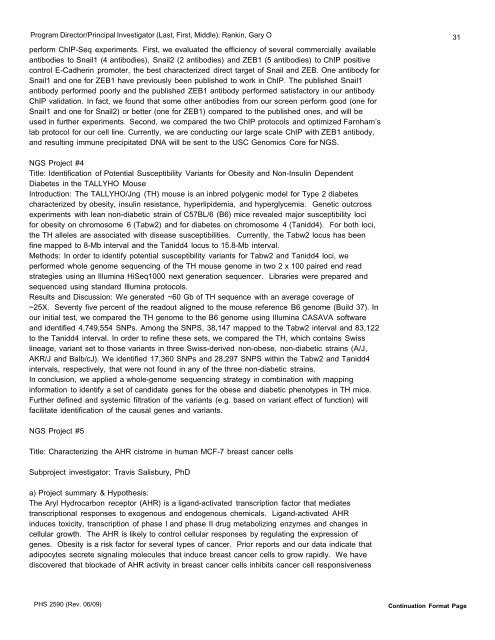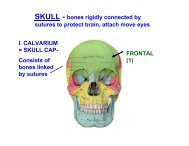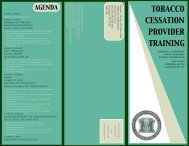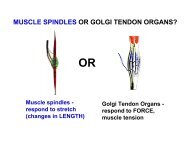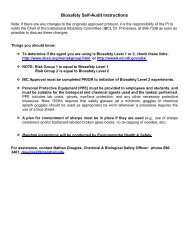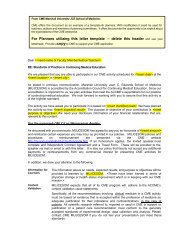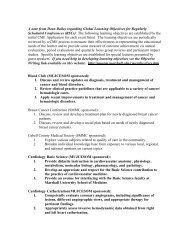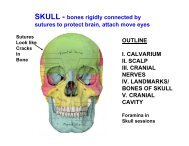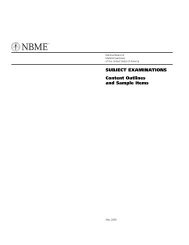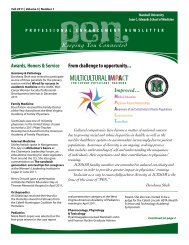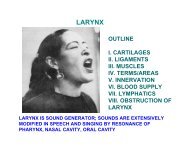FA 5 Progress Report WV-INBRE - Joan C. Edwards School of ...
FA 5 Progress Report WV-INBRE - Joan C. Edwards School of ...
FA 5 Progress Report WV-INBRE - Joan C. Edwards School of ...
- No tags were found...
You also want an ePaper? Increase the reach of your titles
YUMPU automatically turns print PDFs into web optimized ePapers that Google loves.
Program Director/Principal Investigator (Last, First, Middle): Rankin, Gary O 31perform ChIP-Seq experiments. First, we evaluated the efficiency <strong>of</strong> several commercially availableantibodies to Snail1 (4 antibodies), Snail2 (2 antibodies) and ZEB1 (5 antibodies) to ChIP positivecontrol E-Cadherin promoter, the best characterized direct target <strong>of</strong> Snail and ZEB. One antibody forSnail1 and one for ZEB1 have previously been published to work in ChIP. The published Snail1antibody performed poorly and the published ZEB1 antibody performed satisfactory in our antibodyChIP validation. In fact, we found that some other antibodies from our screen perform good (one forSnail1 and one for Snail2) or better (one for ZEB1) compared to the published ones, and will beused in further experiments. Second, we compared the two ChIP protocols and optimized Farnham’slab protocol for our cell line. Currently, we are conducting our large scale ChIP with ZEB1 antibody,and resulting immune precipitated DNA will be sent to the USC Genomics Core for NGS.NGS Project #4Title: Identification <strong>of</strong> Potential Susceptibility Variants for Obesity and Non-Insulin DependentDiabetes in the TALLYHO MouseIntroduction: The TALLYHO/Jng (TH) mouse is an inbred polygenic model for Type 2 diabetescharacterized by obesity, insulin resistance, hyperlipidemia, and hyperglycemia. Genetic outcrossexperiments with lean non-diabetic strain <strong>of</strong> C57BL/6 (B6) mice revealed major susceptibility locifor obesity on chromosome 6 (Tabw2) and for diabetes on chromosome 4 (Tanidd4). For both loci,the TH alleles are associated with disease susceptibilities. Currently, the Tabw2 locus has beenfine mapped to 8-Mb interval and the Tanidd4 locus to 15.8-Mb interval.Methods: In order to identify potential susceptibility variants for Tabw2 and Tanidd4 loci, weperformed whole genome sequencing <strong>of</strong> the TH mouse genome in two 2 x 100 paired end readstrategies using an Illumina HiSeq1000 next generation sequencer. Libraries were prepared andsequenced using standard Illumina protocols.Results and Discussion: We generated ~60 Gb <strong>of</strong> TH sequence with an average coverage <strong>of</strong>~25X. Seventy five percent <strong>of</strong> the readout aligned to the mouse reference B6 genome (Build 37). Inour initial test, we compared the TH genome to the B6 genome using Illumina CASAVA s<strong>of</strong>twareand identified 4,749,554 SNPs. Among the SNPS, 38,147 mapped to the Tabw2 interval and 83,122to the Tanidd4 interval. In order to refine these sets, we compared the TH, which contains Swisslineage, variant set to those variants in three Swiss-derived non-obese, non-diabetic strains (A/J,AKR/J and Balb/cJ). We identified 17,360 SNPs and 28,297 SNPS within the Tabw2 and Tanidd4intervals, respectively, that were not found in any <strong>of</strong> the three non-diabetic strains.In conclusion, we applied a whole-genome sequencing strategy in combination with mappinginformation to identify a set <strong>of</strong> candidate genes for the obese and diabetic phenotypes in TH mice.Further defined and systemic filtration <strong>of</strong> the variants (e.g. based on variant effect <strong>of</strong> function) willfacilitate identification <strong>of</strong> the causal genes and variants.NGS Project #5Title: Characterizing the AHR cistrome in human MCF-7 breast cancer cellsSubproject investigator: Travis Salisbury, PhDa) Project summary & Hypothesis:The Aryl Hydrocarbon receptor (AHR) is a ligand-activated transcription factor that mediatestranscriptional responses to exogenous and endogenous chemicals. Ligand-activated AHRinduces toxicity, transcription <strong>of</strong> phase I and phase II drug metabolizing enzymes and changes incellular growth. The AHR is likely to control cellular responses by regulating the expression <strong>of</strong>genes. Obesity is a risk factor for several types <strong>of</strong> cancer. Prior reports and our data indicate thatadipocytes secrete signaling molecules that induce breast cancer cells to grow rapidly. We havediscovered that blockade <strong>of</strong> AHR activity in breast cancer cells inhibits cancer cell responsivenessPHS 2590 (Rev. 06/09)Continuation Format Page


